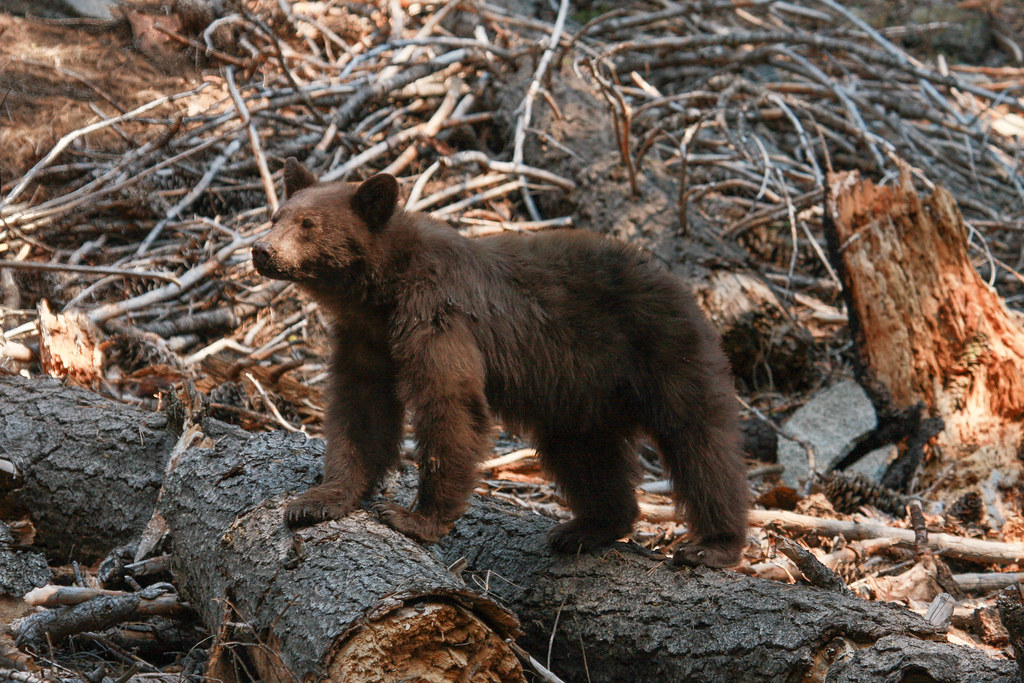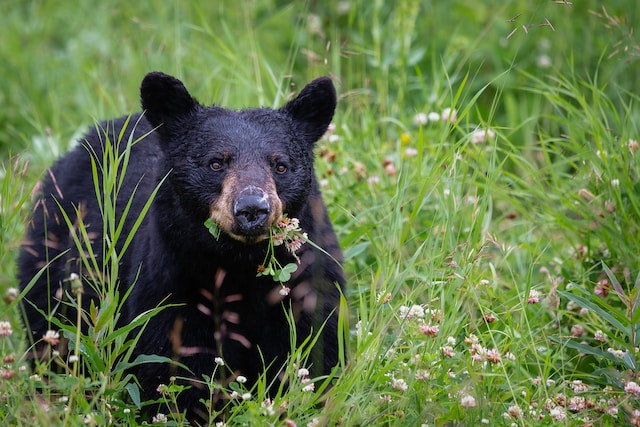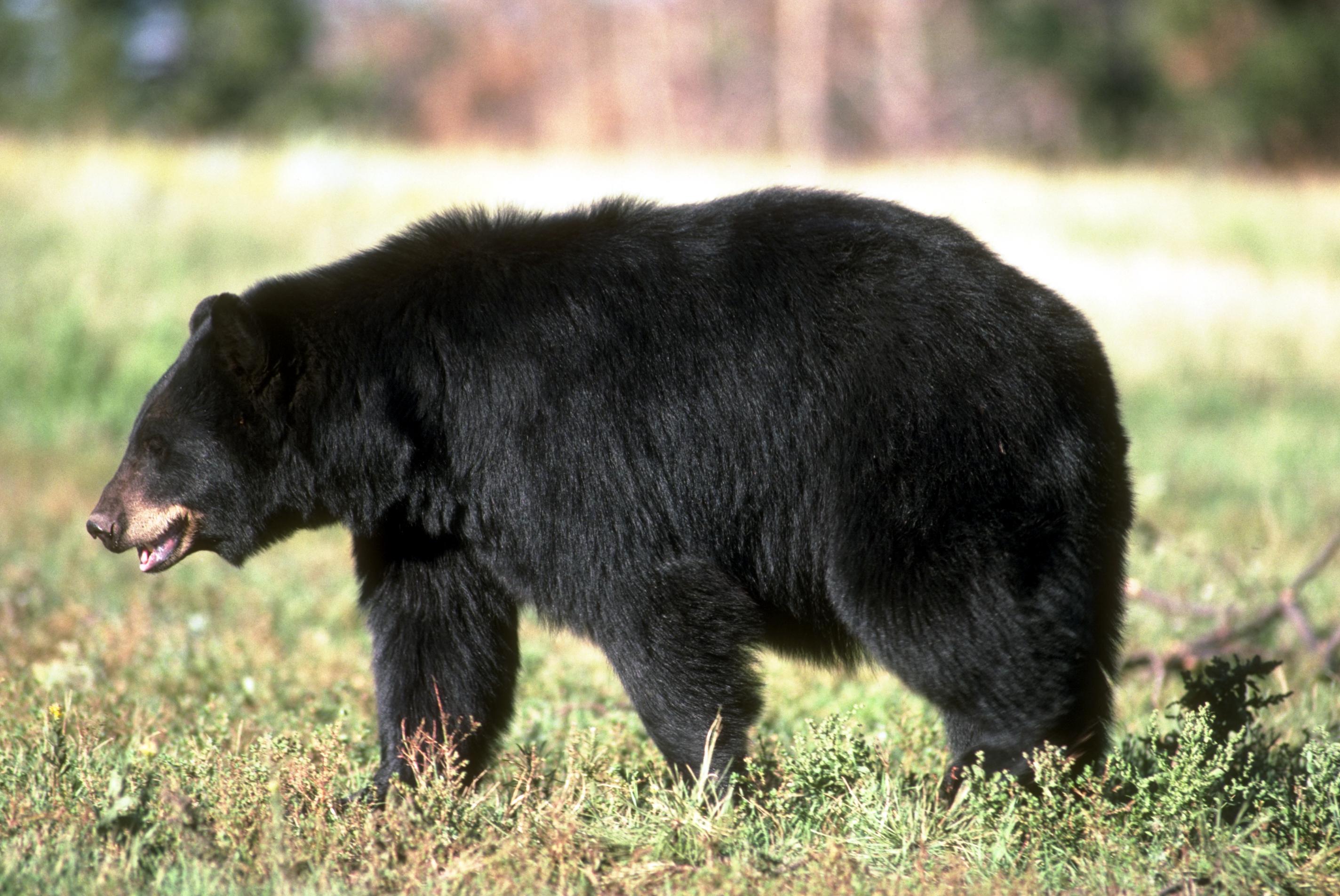Here it is, the Mammoth Lakes Wildlife Highlight you’ve all been waiting for: the American Black Bear! This is our region’s most famous wild animal. And here at Mammoth Mountain Reservations, we get questions all the time about when visitors might be able to see these special furry friends and just how friendly they really are.
There’s lots to cover when it comes to bears, so let’s dig our claws in!
What kinds of bears are in Mammoth Lakes?
Here in the Eastern Sierra, we have the ursus americanus californiensis, or the Californian subspecies of the American Black Bear. And this is confusing for a lot of folks because many of the bears you’ll see in Mammoth are actually brown, cinnamon, or even blonde. Despite the name, the American Black bear comes in a variety of coat colors. So, even if you see a brown bear in Mammoth, it’s not a Brown Bear (ursus arctos.)

Don't let that brown coat fool you. This is an American Black Bear!
What do Black Bears look like?
One of the biggests distinctions between Brown Bears and Black Bears is size. Unlike the Grizzlies of Alaska, which can reach up to 5 feet tall at the shoulder, our bears tend to max out at around 3 and half feet. In terms of weight, American Black Bears typically range between 150 lbs and 300 lbs. But the big guys have been known to reach up to 500 lbs in some cases. That is, of course, a very large animal! But, it’s still smaller than Brown Bears, which can reach weights of up to 700 to 900 lbs.
Another way to distinguish our bears from Brown Bears are their features. Black Bears have a straight snout, and because they don’t sprint across open landscapes like Grizzlies, they lack the muscular hump on their shoulders. Our Black Bears also have shorter, curved claws, which allow them to climb trees and forage for food in fallen logs.
What do they eat?
Black Bears will eat just about whatever edible thing they can get their paws on. But in a natural setting, their diet consists of plants, grasses, nuts and seeds, berries, bugs, honey, birds, bird eggs, and small mammals. Sometimes, they’ll eat fish and young deer or elk, but they typically opt for easier food sources.

When in contact with humans, Black Bears can be pretty bold about going after food. Their excellent sense of smell and strong determination can land them in some very undesirable places, like trash bins, campsites, cars, fishing sites, and sometimes homes.
How strong are bears?
According to some estimates, Black Bears are about five times as strong as humans, and twice as strong as African Lions. This incredible strength allows them to shimmy up a tree in seconds, sprint up to 30 mph, and protect their young from other bears and mountain lions. And even with all of that fur and weight, bears are excellent swimmers.
In terms of those chompers, our bears have a bite force of about 800 PSI. For context, a Doberman has a bite force of 228 PSI.
You can see why, then, it’s fairly easy for a Black Bear to tear a car door off its hinges or break a windshield looking for food.
Are Mammoth Lakes bears dangerous?
The big question is, does that power and size mean that Black Bears are dangerous to humans? Well, we should differentiate between ability and willingness.
On the one hand, a Black Bear is completely capable of inflicting deadly harm on a human. And they will do so if they feel threatened or are protecting their young. Bears that have had too much exposure to humans also become more of a threat as they lose their natural fearfulness.
But, in most cases. though, wild bears want to keep a low profile. They will avoid contact with humans, even if they spot them in the forest. In fact, because Black Bears do not recognize humans as prey, they will not actively seek them out. Still, it’s important to know what to do if you come across a bear in the wild.
What should you do if you see a bear?
First things first, the most important thing to do when you see a bear is remain calm. You want to be able to assess the situation with a clear head, and follow these steps:
-
Face the bear and create distance. It’s never recommended that you run away from a bear, but rather face it head-on. If the bear is not moving, back away or move along the trail slowly, without turning away. Unless you are safely in a car or building, you should not stop to take pictures of a bear. Remember that these guys can break into a run faster than you would expect, and an intimidating charge is one of their common defense mechanisms. So, focus on getting yourself out of the situation.
-
Sternly ward off the bear with your voice. We locals say it all the time: “Go on, bear!” And it’s usually an effective way to let the bear know that you’re human and standing your ground. Don’t stop talking during the encounter. This will keep you calm and let the bear know you’re not looking for a fight.
-
Raise your arms to appear bigger. Waving your arms at a bear while telling them to back off is usually enough to spook them away. The National Park Service recommends that you don’t use any sudden loud noises such as screaming, as that could trigger their predator instinct. However, you’ll often see us locals clapping or banging items together to shoo them away.
-
Use bear spray. Bear encounters here in the Eastern Sierra don’t typically escalate to the point of having to use bear spray. But it’s not a bad idea to have some on you when camping or backpacking.
-
Protect yourself in whatever way possible in the very unusual case of an attack. Again, American Black Bear attacks on humans are exceedingly rare. If, for some reason, a bear does attack you, it’s recommended that you fight back, focusing on the face and sensitive snout.
How can you practice bear safety?
One of the best ways to keep yourself safe from a bear is to discourage them from approaching in the first place. Here are a few ways to do so:
-
Hike in groups
-
Use a bear canister when hiking or camping
-
Don’t store anything scented in your car
-
Close and latch all trash bins (even if it was open before you)
-
Use the bear-proof bin at your campsite
-
Don’t throw food scraps or fish remains on the ground

Here in Mammoth, we all do our part to keep our bears wild!
Cohabitating safely with bears as our wild neighbors takes awareness and dedication. By making sure our bears don’t have access to food sources in town and giving them their space in their natural habitat, they remain wild and self-reliant.
Book your next trip to the bear country with Mammoth Mountain Reservations and you just might see one of these amazing animals!
